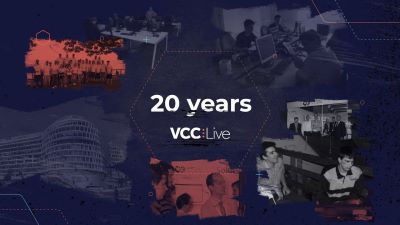Last week VCC Live® attended the CCW 2019 conference in Berlin, Europe’s largest trade fair and conference for call centers, customer service and customer dialogue. The latest call center technologies and the industry’s most creative minds – all in one place!
Year after year, the conference attracts thousands of visitors as well as the most innovative companies showcasing their solutions. This year 8,000 visitors and 270 exhibitors attended CCW 2019 to leverage networking and gain valuable insights into the call center industry from more than 50 speakers and 120 lectures.
Amongst other things, digital disruption, ‘healthy’ call centers, artificial intelligence and changing customer needs were all in the spotlight. And as the 21st CCW is now over, it’s time for the takeaways, so here are our key findings from the conference!
Know when to change your mindset
In our fast-paced world, everything is on the move, with technologies constantly evolving and customer behavior continuously changing. In such an accelerated business environment, companies not only need to stay ahead of the competition – they need to be able to know when to change their mindset as well.
One thing is for sure: what is a huge trend one day can become outdated in the blink of an eye. Just think of Kodak, the (once) biggest film company in the world that in 2012 filed for bankruptcy, after failing to deal with the challenges of digital technology.
Where did Kodak go wrong? It’s simple: their mindset. They failed to recognize the huge potential of the digital age and refused to make the jump, assuming that their customers would remain loyal to them regardless.
An important lesson, reinforced at CCW 2019, is that making assumptions about your customers will result in you losing them. Instead, the advice is to try and focus on their (changing) needs and improve your products/services accordingly.
CX is still on the rise
In an age of exceptionally high customer expectations, CCW 2019 again confirmed that customer experience (CX) has emerged as the next game changer in customer service.
Craig Plamer, Director of CX Europe at Verizon, highlighted that in order to create a meaningful CX, companies need to have a user-first mindset, rely on engaged employees, and involve customers in the creation of the experience.
Why focus on CX? Amongst other things, it builds customer trust, aligns services to brand values, promotes loyalty and helps achieve business goals.
Another speaker at the conference mentioned that 44% of customers are willing to spend more time with an agent if that agent can actually help them. It is not surprising then, that CX is still on the rise and is expected to be even more important in the upcoming years.
Automation and socializing chatbots
Another major message at the conference was that the future of customer service will be the cloud, automation, data and artificial intelligence.
As Paula Bode from Salesforce said, when talking about AI: “Chatbots can already handle the first 5-10 minutes of a conversation, and customers are comfortable interacting with them if they know they can be switched to a live agent anytime.”
In addition, Darius Heising from Kyron Systems highlighted robotic process automation can help boost your call center’s performance. If you are not aware of it, robotic process automation (RPA) is the application of technology that enables computer software or a robot to capture and interpret existing applications to help process a transaction, manipulate data, trigger responses and communicate with other digital systems.
Repetitive tasks, for instance, are definitely a daily challenge for call centers. Robotics, however, can be used to deal with such issues, allowing your agents to work on more complex issues.
And what will the future bring for chatbots? As we all know, chatbots are usually good at one thing only. But what if they could talk and help each other answering customer queries?
Well, it seems that the age of socializing chatbots is coming: according to one speaker, chatbots will soon be able to look for an answer by talking to each other. For example, if a customer has an insurance-related question, but the chatbot they are communicating with is programmed to only be able to answer healthcare-related questions, the bot can simply connect to an insurance chatbot and ask them to answer the customer’s question. Amazing, right?
‘Healthy’ call centers
In the call center industry, everything is increasing: customer expectations, emphasis on CX, call volumes and issue complexity.
For call agents, the number one challenge they increasingly face is complex customer problems. And, with technology ever-advancing, it seems that things are only going to get more complex in the coming years. One of the results of this trend is that agents are increasingly struggling with technological issues with a resulting (negative) effect on their ability to maintain a healthy work-life balance.
As such, an important issue discussed at the conference was that agent well-being in a customer-centric era is more important than ever. In other words, businesses should try and run ‘healthy’ call centers.
And how is it possible to keep your call center healthy? Give your agents the right technological tools, customer data and training!
Furthermore, put your employees first! As one of the presentations highlighted, agents want a more flexible working environment, better technology, more training and data-driven feedback from their managers. So, the solution is in your hands: listen to your agents and focus on making sure they never have a reason to consider leaving their job.
CCW 2019 was an exciting experience for VCC Live®, not only in terms of doing business with potential customers but also in gaining industry knowledge and finding out more about the trends and changes that are shaping the future of the contact center industry. Keep these lessons mentioned above in mind, you too will be able to level up your customer service. We’re hoping to be able to bring you insights from next year’s CCW conference as well!







